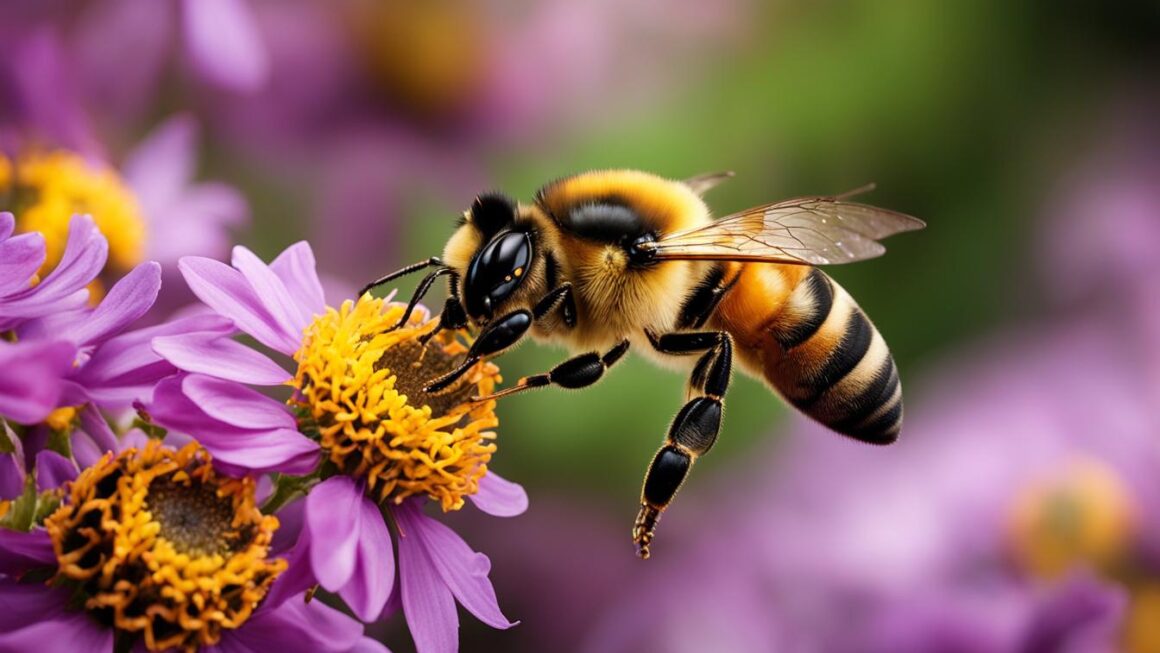Carpenter bees in Texas are a common nuisance for homeowners. They are solitary bees that prefer to build their nests in older or untreated wood. Carpenter bees have a round, robust body and are mostly black, with males having a white or yellow face. Female carpenter bees create galleries in wooden structures on your property, such as fences, decks, and houses, which can lead to severe structural damage if left untreated. In Texas, there are also other types of bees, such as leafcutter bees, sweat bees, and mason bees, which have their own unique characteristics.
Key Takeaways:
- Carpenter bees in Texas prefer to nest in weathered or untreated wood that is more than two inches thick.
- Signs of a carpenter bee infestation in Texas include large black bees hovering near wooden structures and round, smooth holes drilled in the wood.
- Carpenter bees can cause significant damage to wooden structures, and woodpeckers are often attracted to their larvae.
- Professional pest control is recommended for severe carpenter bee infestations, but DIY measures such as homemade traps and natural repellents can also be effective.
- Practicing bee conservation and taking proactive prevention measures can help protect the diverse bee population in Texas.
Habitat and Behavior of Carpenter Bees in Texas
Carpenter bees in Texas have specific preferences when it comes to their habitat and behavior. Understanding these characteristics can help homeowners effectively deal with these pests and prevent potential damage to their property.
Habitat
Carpenter bees in Texas are commonly found nesting in weathered or untreated wood that is more than two inches thick. They can be found in various wooden structures, including trees, roof eaves, rafters, wooden trim or siding, decks, fences, and outdoor furniture. These bees prefer to create their nests in wood that is already damaged or decaying.
Behavior
Female carpenter bees are responsible for creating smooth, round holes in the wood, which serve as their galleries for laying eggs. These holes are approximately the diameter of their own bodies. The larvae inside the galleries can attract woodpeckers, who can further damage the wood while searching for food.
Male carpenter bees, although more aggressive in nature, do not possess a stinger and are generally harmless. Females, on the other hand, have a stinger but are mostly docile unless provoked or threatened.
It is important to note that while carpenter bees can be a nuisance, they play a vital role in pollination and maintaining ecosystems. Taking proactive measures to prevent carpenter bee infestations can help protect both your property and the bee population in Texas.
| Habitat | Behavior | |
|---|---|---|
| Preferences | Weathered or untreated wood more than two inches thick | Female carpenter bees create smooth holes in wood for nesting |
| Locations | Trees, roof eaves, rafters, wooden trim or siding, decks, fences, outdoor furniture | Male carpenter bees are aggressive but lack a stinger, females have a stinger but are generally docile |
| Impacts | Can cause structural damage to wooden structures | Woodpeckers may be attracted to the larvae, causing additional damage |
Signs of Carpenter Bee Infestation in Texas
Carpenter bees can cause significant damage to wooden structures, making it essential to identify the signs of infestation early on. By recognizing these signs, homeowners can take prompt action to address the problem before it worsens.
Visual Indicators
One of the most apparent signs of a carpenter bee infestation in Texas is the presence of large black bees hovering near wooden structures. These bees have smooth abdomens, distinguishing them from bumble bees with fuzzy abdomens. Additionally, you may notice round, smooth holes drilled in the wood, typically with a diameter similar to the carpenter bee’s body. Often, small piles of sawdust can be found near these holes, indicating recent activity. It is important to note that these holes can vary in size, ranging from a few inches to several feet if reused over time. Lastly, woodpecker activity around the holes can be an indirect sign of a carpenter bee infestation, as these birds are attracted to the larvae inside the galleries.
Distinctive Behavior
Observing the behavior of carpenter bees can also provide insights into potential infestations. Male carpenter bees are more aggressive but lack a stinger, making them less of a threat. Meanwhile, female carpenter bees have a stinger but are generally docile unless provoked. Their preference for nesting in untreated or weathered wood makes homes, fences, decks, and outdoor furniture vulnerable to infestation. Keep an eye out for these behavioral patterns and the specific locations where carpenter bees are frequently spotted.
Professional Inspection
If you suspect a carpenter bee infestation but are unsure of the extent, it is recommended to seek professional inspection and guidance. Pest control professionals can thoroughly assess your property, identifying all galleries and assessing the extent of the damage. They can provide expert advice on treatment options and develop a tailored plan to address the infestation effectively.
Understanding the signs of a carpenter bee infestation in Texas is crucial for timely intervention and prevention of further damage. By keeping a watchful eye on visual indicators and behavioral patterns, homeowners can take proactive measures to protect their wooden structures from these destructive pests.
The Dangers of Carpenter Bees in Texas
Carpenter bees may not be aggressive insects, but they can wreak havoc on your wooden structures if left unchecked. The holes they create in the wood can weaken its integrity, leading to potential structural issues over time. Additionally, their presence can attract woodpeckers, who will peck at the wood in search of carpenter bee larvae, causing further damage.
To illustrate the damage caused by carpenter bees and woodpeckers, consider the following:
| Damage Type | Description |
|---|---|
| Carpenter Bee Holes | The round, smooth holes drilled by carpenter bees not only compromise the structural integrity of the wood, but they also create an entry point for moisture, which can lead to rot and decay. |
| Woodpecker Pecking | Woodpeckers, attracted to the sound and vibrations emitted by carpenter bee larvae inside the wood, will peck at the holes created by the bees. This pecking causes additional damage and can create larger openings for moisture to enter. |
Addressing a carpenter bee infestation promptly is vital to prevent costly repairs and potential safety hazards. By taking action to eliminate these pests and mitigate woodpecker damage, you can protect the structural integrity of your wooden structures and ensure the long-term stability of your property.
Controlling Carpenter Bees in Texas
If you’re dealing with a carpenter bee infestation in Texas, it’s essential to take action to control and remove these pests from your property. While DIY measures can be effective for mild infestations, hiring a professional pest control company experienced in dealing with carpenter bees is the most reliable solution to ensure complete eradication.
Professional carpenter bee removal services typically involve a thorough inspection of your property to identify all the gallery holes and nests. The exterminators will then treat the affected areas with appropriate insecticides or dust to eliminate the bees and prevent future infestations. They may also provide advice on preventing carpenter bees from returning, such as sealing cracks and crevices or treating wood with protective coatings.
Attempting to control carpenter bees on your own can be challenging, as they can establish nests in hard-to-reach areas or multiple locations on your property. Moreover, misidentification or improper treatment can lead to incomplete removal, allowing the infestation to persist or worsen over time. By opting for professional carpenter bee removal, you can have peace of mind knowing that the problem will be effectively addressed, minimizing the risk of property damage and ensuring the safety of your home.
| Problems with DIY Carpenter Bee Control | Benefits of Professional Carpenter Bee Removal |
|---|---|
| Difficulty locating all gallery holes and nests | Thorough inspection to identify all affected areas |
| Incomplete removal, leading to recurring infestations | Complete eradication of carpenter bees |
| Possible misidentification and improper treatment | Expert knowledge and experience in carpenter bee control |
| Higher risk of property damage and injury | Minimized risk of property damage and injury |
Remember, addressing a carpenter bee infestation promptly is crucial to prevent further damage to your home. Whether you choose to hire professionals or tackle the problem on your own, taking action to control carpenter bees is vital for the integrity and longevity of your wooden structures.
Prevention Tips for Carpenter Bee Infestations in Texas
Carpenter bees in Texas can be a nuisance for homeowners, but there are steps you can take to prevent infestations and protect your property. By implementing some simple prevention tips, you can make your home less attractive to carpenter bees and reduce the risk of structural damage.
1. Treat Wooden Structures
A key step in preventing carpenter bee infestations is treating wooden structures with paint, stain, or other wood treatments. Carpenter bees are attracted to untreated or weathered wood, so by applying a protective coating, you can make the wood less appealing for nesting. Be sure to cover all exposed surfaces, including fences, decks, and outdoor furniture.
2. Seal Cracks and Gaps
Another method to deter carpenter bees is to seal any cracks or gaps in your home’s exterior. Bees can use these openings to access the interior of your property, so it’s important to inspect and repair any areas where they could potentially gain entry. Use caulk or other appropriate sealants to close off gaps around windows, doors, and utility lines.
3. Inspect and Maintain Screens
Carpenter bees can enter your home through damaged or improperly fitting window and door screens. To prevent this, regularly inspect your screens for any tears or holes and repair or replace them as needed. Ensuring that screens fit snugly and are in good condition will help keep carpenter bees and other pests from entering your home.
4. Remove Decaying Wood
To eliminate potential nesting sites, it’s important to remove any old or decaying wooden items from your property. This includes things like play structures, firewood stacks, or old furniture. By removing these attractive places for carpenter bees to nest, you can significantly reduce the chances of an infestation.
By following these prevention tips, you can minimize the risk of carpenter bee infestations in Texas and protect your property from potential damage. Remember, early action is key, so be proactive in implementing these measures to keep carpenter bees at bay.

The Importance of Bee Conservation in Texas
While carpenter bees can be a nuisance, it is important to remember that bees, in general, play a crucial role in pollination and maintaining ecosystems. Texas has a diverse bee population, including native species like mason bees and leafcutter bees. These bees are essential for pollinating crops and native plants. It is crucial to practice bee conservation by creating bee-friendly habitats, avoiding the use of pesticides harmful to bees, and supporting local beekeepers and conservation organizations.
Bees are not only important for agricultural purposes but also for the overall health of our environment. They contribute to the biodiversity of our ecosystems and help sustain various plant species. Without bees, many plants would struggle to reproduce, impacting the entire food chain. By conserving bees in Texas, we can protect not only these essential pollinators but also the entire natural balance of our ecosystem.
The Role of Bee Conservation
Conserving bees involves creating suitable environments that support their habitats and food sources. This can include planting native wildflowers, avoiding the use of pesticides and herbicides, and providing nesting sites such as bee boxes or hollowed logs. Supporting local beekeepers and conservation organizations through donations or volunteering can also contribute to bee conservation efforts.
By conserving bees in Texas, we are not only protecting the bee population but also safeguarding the future of our agriculture, food sources, and natural landscapes. Without bees, the pollination process would be severely compromised, leading to a decline in fruit and vegetable production. This would not only impact our local economy but also our ability to sustain ourselves with nutritious, diverse food options.
| Benefits of Bee Conservation in Texas | Threats to Bee Populations |
|---|---|
|
|
By understanding the importance of bee conservation and taking proactive measures to support these valuable pollinators, we can contribute to the preservation of Texas’ bee population and ensure a healthy and thriving ecosystem for future generations.

Professional Carpenter Bee Removal in Texas
If you are dealing with a severe carpenter bee infestation in Texas and DIY methods have not been effective, it is recommended to seek professional carpenter bee removal services. Pest control companies experienced in dealing with carpenter bees can safely and efficiently eliminate the infestation, protect your property from further damage, and provide expert advice on long-term prevention. Hiring professionals ensures that the extermination process is done correctly and minimizes the risk of injury or incomplete removal.
Professional pest control technicians have the knowledge, tools, and specialized equipment to identify all the gallery holes that carpenter bees have drilled and treat them effectively. They can also assess the extent of the infestation and determine the best course of action to eliminate the bees and prevent future infestations.
By hiring professional carpenter bee removal services, you can save time and effort, as well as ensure the safety of yourself and your property. DIY methods may not be as effective, and you may risk incomplete removal of the bees, leading to recurring infestations. Additionally, professionals can provide valuable advice on long-term prevention strategies to protect your property from carpenter bees in the future.
Benefits of Professional Carpenter Bee Removal Services
- Expertise and experience in dealing with carpenter bee infestations
- Identification and treatment of all gallery holes
- Efficient elimination of the infestation
- Protection of your property from further damage
- Minimization of the risk of injury during the extermination process
- Expert advice on long-term prevention
- Saves time and effort compared to DIY methods
Choosing a Professional Pest Control Company
When selecting a professional pest control company for carpenter bee removal in Texas, it is important to consider their experience and expertise in dealing specifically with carpenter bees. Look for companies that offer a guarantee on their services and have positive customer reviews and testimonials. It’s also a good idea to request a quote and compare prices and services from multiple companies before making a decision.
| Company | Experience | Price | Customer Reviews |
|---|---|---|---|
| ABC Pest Control | 15 years | $200 – $300 | 4.5/5 |
| XYZ Exterminators | 10 years | $250 – $350 | 4/5 |
| Pest Masters | 20 years | $300 – $400 | 5/5 |
By choosing a reputable pest control company with experience in carpenter bee removal, you can ensure effective and reliable service to eliminate your carpenter bee infestation in Texas.
DIY Carpenter Bee Control Measures in Texas
While it is recommended to seek professional help for severe carpenter bee infestations, there are some DIY measures you can take to control carpenter bees in Texas. Homemade traps and natural repellents can be effective in deterring carpenter bees from nesting in your property.
Homemade Carpenter Bee Traps
One DIY method to control carpenter bees is by creating homemade traps. These traps can be made using wooden blocks or containers filled with enticing materials to attract the bees. Once the bees enter the trap, they will become trapped and can be safely removed from your property. Remember to place the traps near the areas where you have observed carpenter bee activity.
Natural Carpenter Bee Repellents
Another DIY approach is to use natural repellents to deter carpenter bees. Essential oils like citrus or peppermint can be effective in repelling these bees. Simply mix a few drops of the chosen essential oil with water and spray it on the wooden surfaces where carpenter bee activity is prominent. Reapply the repellent regularly, especially after rain or heavy moisture, to maintain its efficacy.
While these DIY methods may provide temporary relief from carpenter bee infestations, it’s important to note that they may not be as effective as professional pest control. Ongoing maintenance and monitoring may be required to ensure long-term control of carpenter bees.
Conclusion
In conclusion, effectively getting rid of carpenter bees in Texas requires early intervention and a comprehensive approach to control and prevent infestations. These bees can cause significant damage to wooden structures if left untreated, making prompt identification and treatment crucial.
Hiring a professional pest control company experienced in dealing with carpenter bees is the most effective solution. They can safely eliminate the infestation, protect your property from further damage, and provide expert advice on preventing future infestations.
Moreover, it is important to practice long-term prevention measures to mitigate the risks associated with carpenter bees. Treating wooden structures with paint, stain, or other treatments, sealing gaps and cracks, and removing decaying wooden items are proactive steps that can help deter carpenter bees from nesting on your property.
By implementing these control and prevention measures, you can ensure the safety and integrity of your property, while also contributing to the preservation of Texas’ diverse bee population.
FAQ
What are the signs of a carpenter bee infestation in Texas?
Signs of a carpenter bee infestation in Texas include large black bees hovering near wooden structures, round holes drilled in the wood, and woodpecker activity around the holes.
Are carpenter bees dangerous?
While carpenter bees are not aggressive and rarely sting, they can cause significant damage to wooden structures if left untreated.
How can I prevent carpenter bee infestations in Texas?
To prevent carpenter bee infestations in Texas, you can treat wooden structures with paint or stain, seal any gaps or cracks in your home’s exterior, inspect and maintain screens, and remove decaying wooden items from your property.
Why is bee conservation important in Texas?
Bee conservation is important in Texas as bees, including native species, are crucial for pollination and maintaining ecosystems.
Should I hire professional carpenter bee removal services in Texas?
If you are dealing with a severe carpenter bee infestation in Texas, it is recommended to seek professional carpenter bee removal services to ensure effective and safe removal.
What are some DIY carpenter bee control measures in Texas?
Some DIY carpenter bee control measures in Texas include using homemade traps and natural repellents made from essential oils.




